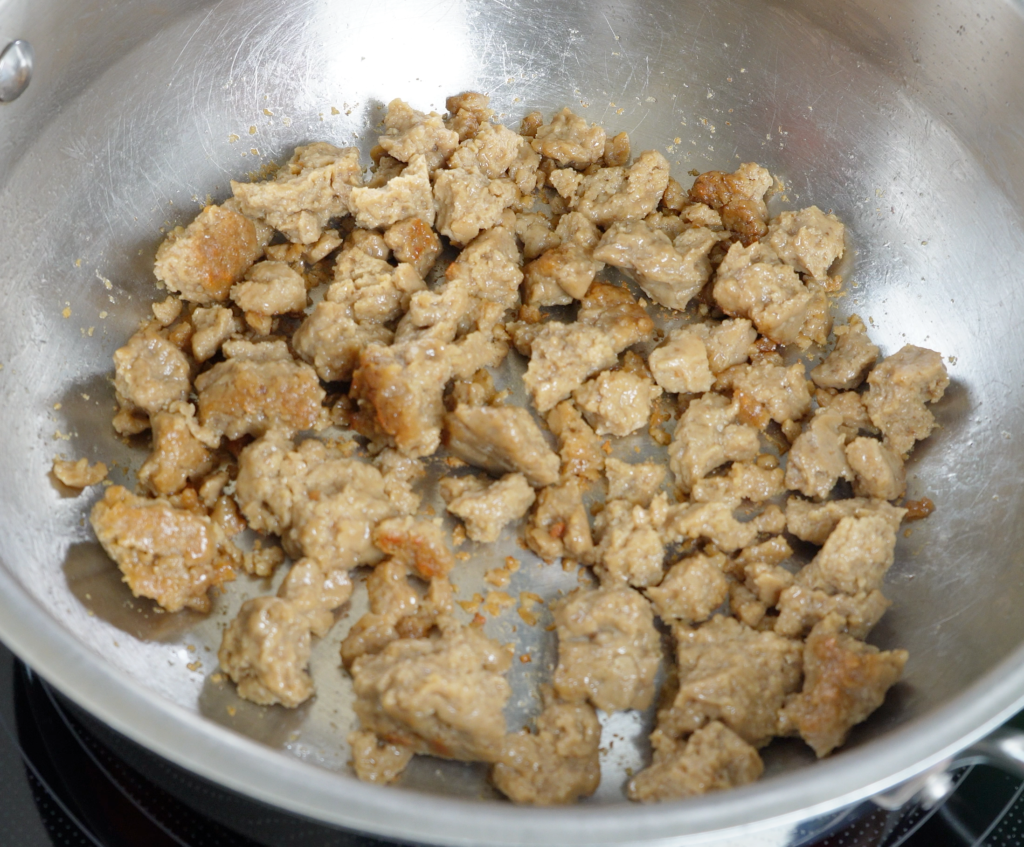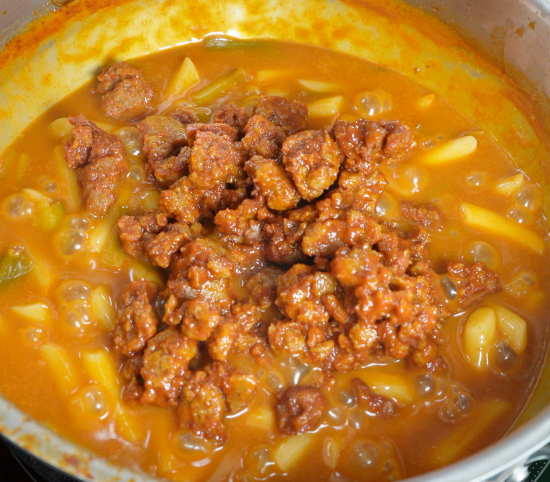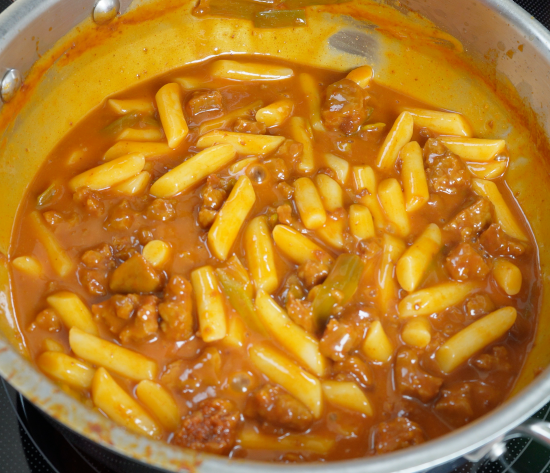Description

This classic Korean street food recipe has a vegan twist. Seitan adds a hearty meatiness to the dish. The savory and spicy flavor profile comes from gochujang. While the tteokbokki have a delicate and chewy texture.
Overview
My first interactions with tteokbokki and gochujang were through a care package from my childhood best friend. Very grateful but I was also a little bewildered since I had never used either ingredient before.
In the following sections I walk through what these two ingredients are and what they provide to this dish. The TLDR explanation for the uninitiated is that gochujang is a fermented chili paste and tteokbokki are thick and chewy rice noodles.
This Korean street food inspired recipe comfortably serves two. But you can easily scale up or scale down the portions as needed. It is easy, quick, and delicious.
Special Ingredients
Tteokbokki
Tteokbokki, also known as rice cakes, is a beloved Korean street food cooked in a sweet and spicy sauce, typically made with gochujang. The dish is often served hot, with the rice cakes coated in a vibrant red sauce and garnished with green onions. The chewy texture provides a satisfying contrast to the bold and spicy sauce. Resulting in a delightful combination of flavors and textures.
Gochujang
Gochujang is a traditional Korean condiment made from a combination of ingredients including: gochu-garu (chili powder), glutinous rice, meju-garu (fermented soybean powder), yeotgireum (barley malt powder), and salt. The fermentation process gives gochujang its distinctive umami flavor profile. It is a thick paste that is reddish-brown in color with a medium spiciness level. It is used in soups, stews, stir-fries, and as a dipping sauce. Gochujang is also known as Korean red chili paste or gochu-jang.

Cooking Notes
Seitan Marinade and Prep Work
Heat the water in a microwave safe measuring cup for a minute or two. The heated water will help the other ingredients dissolve much easier. Add the marinade ingredients in a small bowl or large measuring cup and stir until combined.
For this recipe we chose to keep it simple, so we only included green onions. The chopped ends are used as a garnish. Whereas, the leafy tops are cooked in the dish.
Chop the ends off the green onions and discard. Then chop the green onion until you start to get to the leafy part. Put the chopped green onion into a small bowl and set off to the side. These will be used as a garnish when the dish is completed.




Roughly chop the leafy tops of the green onions and place in a separate bowl. These will be added to the skillet and cooked in the dish.
Sautéing the Seitan
With the prep work out of the way we can move on to cooking the seitan. Bring a skillet up to medium heat and add a tablespoon of olive oil. When the pan is up to temperature break apart the seitan over the skillet into small pieces. Stir the seitan with a silicone spatula to prevent anything from sticking to the pan. Cook until the seitan starts to brown.
Add the marinade to the seitan and periodically stir the contents with a spatula. Continue to cook the seitan until most of the liquid has evaporated. Then remove the seitan from the skillet by placing in a large bowl. Set the bowl off to the side for now and proceed to cooking the rice cakes.
Spicy Rice Cakes
Place the water, followed by, the gochujang in the skillet. Next, add the soy sauce, sugar, and sesame seed oil. Stir the ingredients until they are combined. Then add the rice cakes (tteokbokki) and stir them into the sauce. Bring the skillet up to a simmer and cook until the sauce starts to thicken. Add the green onion tops at this stage and continue to cook until they are tender. Once the sauce thickens add the sautéed seitan in the skillet and stir to combine.
To serve add the spicy rice cakes with seitan to a bowl. Garnish with green onions and sesame seeds. Feel free to try other toppings such as sriracha, seaweed sheets or flakes, kimchi, or soy sauce. One thing is certain, this meaty, spicy, and chewy dish is sure to impress. Enjoy!
Storage
Place any remaining leftovers in your storage container of choice. Reserve the remaining chopped green onion in a separate container. The leftovers should keep nicely for up to a week in the refrigerator before the freshness starts to taper off. To extend the shelf life you can freeze the leftovers.





If you like this recipe be sure to check out our other recipes below:
Ingredients
2 1/2 cups water
1/4 cup gochujang
2 Tbsp. soy sauce
2 Tbsp. sugar
3 cups Korean rice cakes aka Tteokbokki
1 teaspoon sesame seed oil
green onions, divided and chopped
1 – 8 oz. container of seitan
Seitan Marinade
1/2 cup water plus 1 teaspoon Better than Bouillon
1 Tbsp. soy sauce
1 teaspoon sriracha
2 Tbsp. tomato paste
1 clove garlic, pressed
Directions
- Start by prepping the seitan marinade. Heat the water in a microwave safe measuring cup by placing it in a microwave for a minute or two. This will help the remaining ingredients dissolve. Add all the seitan marinade ingredients to a small bowl and stir until combined.
- Chop the green onions into two pieces. Roughly chop the top leafy greens and place in a small bowl. Chop the end closest to the roots and place in a separate bowl to be used as a garnish.
- Bring a skillet up to medium heat and add a tablespoon of olive oil. Cook the seitan until it starts to brown. Then add the seitan marinade and cook until the sauce thickens. Remove the seitan from the skillet by placing in a large bowl.
- Add the water, gochujang, soy sauce, sugar, and sesame seed oil to the skillet. Stir to combine. Then add the spicy rice cakes and the green onion tops. Cook until the sauce starts to thicken.
- Once the sauce has thickened place the cooked marinated seitan in the skillet and cook until it is brought back up to temperature.
- Serve by placing in a bowl and garnish with sesame seeds and the chopped green onions.